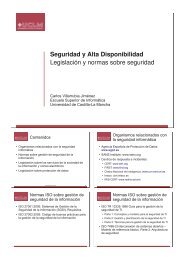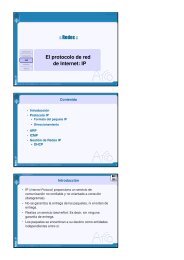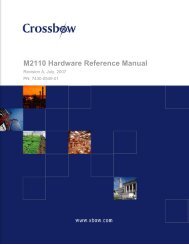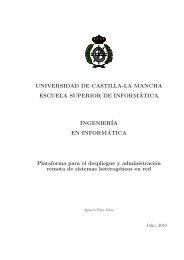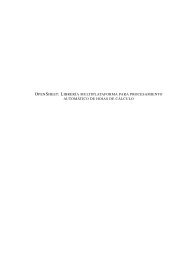×
Your ePaper is waiting for publication!
By publishing your document, the content will be optimally indexed by Google via AI and sorted into the right category for over 500 million ePaper readers on YUMPU.
This will ensure high visibility and many readers!
PUBLISH DOCUMENT
No, I renounce more range.
You can find your publication here:
Share your interactive ePaper on all platforms and on your website with our embed function
⬤
⬤
Pensar en C++ (Volumen 1) - Grupo ARCO
Pensar en C++ (Volumen 1) - Grupo ARCO
Pensar en C++ (Volumen 1) - Grupo ARCO
SHOW MORE
SHOW LESS
You also want an ePaper? Increase the reach of your titles
YUMPU automatically turns print PDFs into web optimized ePapers that Google loves.
✐<br />
✐<br />
✐<br />
“Volum<strong>en</strong>1” — 2012/1/12 — 13:52 — page 308 — #346<br />
✐<br />
Capítulo 11. Las refer<strong>en</strong>cias y el constructor de copia<br />
11.2. Refer<strong>en</strong>cias <strong>en</strong> <strong>C++</strong><br />
Una refer<strong>en</strong>cia (&) es como un puntero constante que se de-refer<strong>en</strong>cia automáticam<strong>en</strong>te.<br />
Normalm<strong>en</strong>te se utiliza <strong>en</strong> la lista de argum<strong>en</strong>tos y <strong>en</strong> el valor de retorno de<br />
de las funciones. Pero también se puede hacer una refer<strong>en</strong>cia que apunte a algo que<br />
no ha sido asignado. Por ejemplo:<br />
//: C11:FreeStandingRefer<strong>en</strong>ces.cpp<br />
#include <br />
using namespace std;<br />
// Ordinary free-standing refer<strong>en</strong>ce:<br />
int y;<br />
int& r = y;<br />
// Wh<strong>en</strong> a refer<strong>en</strong>ce is created, it must<br />
// be initialized to a live object.<br />
// However, you can also say:<br />
const int& q = 12; // (1)<br />
// Refer<strong>en</strong>ces are tied to someone else’s storage:<br />
int x = 0; // (2)<br />
int& a = x; // (3)<br />
int main() {<br />
cout
✐ ✐ ✐ “Volum<strong>en</strong>1” — 2012/1/12 — 13:52 — page 308 — #346 ✐ Capítulo 11. Las refer<strong>en</strong>cias y el constructor de copia 11.2. Refer<strong>en</strong>cias <strong>en</strong> <strong>C++</strong> Una refer<strong>en</strong>cia (&) es como un puntero constante que se de-refer<strong>en</strong>cia automáticam<strong>en</strong>te. Normalm<strong>en</strong>te se utiliza <strong>en</strong> la lista de argum<strong>en</strong>tos y <strong>en</strong> el valor de retorno de de las funciones. Pero también se puede hacer una refer<strong>en</strong>cia que apunte a algo que no ha sido asignado. Por ejemplo: //: C11:FreeStandingRefer<strong>en</strong>ces.cpp #include using namespace std; // Ordinary free-standing refer<strong>en</strong>ce: int y; int& r = y; // Wh<strong>en</strong> a refer<strong>en</strong>ce is created, it must // be initialized to a live object. // However, you can also say: const int& q = 12; // (1) // Refer<strong>en</strong>ces are tied to someone else’s storage: int x = 0; // (2) int& a = x; // (3) int main() { cout
✐ ✐ ✐ “Volum<strong>en</strong>1” — 2012/1/12 — 13:52 — page 309 — #347 ✐ 11.2. Refer<strong>en</strong>cias <strong>en</strong> <strong>C++</strong> mismo pasando un puntero como argum<strong>en</strong>to, pero una refer<strong>en</strong>cia es sintácticam<strong>en</strong>te más clara. (Si lo desea, puede p<strong>en</strong>sar que una refer<strong>en</strong>cia es, nada más y nada m<strong>en</strong>os, más conv<strong>en</strong>i<strong>en</strong>te sintácticam<strong>en</strong>te). Si una función retorna una refer<strong>en</strong>cia, ha de t<strong>en</strong>er el mismo cuidado que si la función retornara un puntero. La refer<strong>en</strong>cia que se devuelva debe estar ligada a algo que no sea liberado cuando la función retorne. Si no, la refer<strong>en</strong>cia se referirá a un trozo de memoria sobre el que ya no ti<strong>en</strong>e control. He aquí un ejemplo: //: C11:Refer<strong>en</strong>ce.cpp // Simple <strong>C++</strong> refer<strong>en</strong>ces int* f(int* x) { (*x)++; return x; // Safe, x is outside this scope } int& g(int& x) { x++; // Same effect as in f() return x; // Safe, outside this scope } int& h() { int q; //! return q; // Error static int x; return x; // Safe, x lives outside this scope } int main() { int a = 0; f(&a); // Ugly (but explicit) g(a); // Clean (but hidd<strong>en</strong>) } ///:~ La llamada a f() no ti<strong>en</strong>e la v<strong>en</strong>taja ni la claridad que la utilización de refer<strong>en</strong>cias, pero está claro que se está pasando una dirección mediante un puntero. En la llamada a g(), también se pasa una dirección (mediante una refer<strong>en</strong>cia), pero no se ve. Refer<strong>en</strong>cias constantes El argum<strong>en</strong>to refer<strong>en</strong>cia <strong>en</strong> Refer<strong>en</strong>ce.cpp funciona solam<strong>en</strong>te <strong>en</strong> caso de que el argum<strong>en</strong>to no sea un objeto constante. Si fuera un objeto constante, la función g() no aceptaría el argum<strong>en</strong>to, lo cual es positivo porque la función modificaría el argum<strong>en</strong>to que está fuera de la función. Si sabe que la función respetará las constancia un objeto, el hecho de que el argum<strong>en</strong>to sea una refer<strong>en</strong>cia constante permitirá que la función se pueda utilizar <strong>en</strong> cualquier situación. Esto significa que para tipos predefinidos, la función no modificará el argum<strong>en</strong>to, y para tipos definidos por el usuario, la función llamará solam<strong>en</strong>te a métodos constantes, y no modificara ningún atributo público. La utilización de refer<strong>en</strong>cias constantes <strong>en</strong> argum<strong>en</strong>tos de funciones es especialm<strong>en</strong>te importante porque una función puede recibir un objeto temporal. Éste podría 309 ✐ ✐ ✐ ✐
Page 1 and 2: ✐ ✐ ✐ “Volumen1” — 2012
Page 3 and 4: ✐ ✐ ✐ “Volumen1” — 2012
Page 5 and 6: ✐ ✐ ✐ “Volumen1” — 2012
Page 7 and 8: ✐ ✐ ✐ “Volumen1” — 2012
Page 9 and 10: ✐ ✐ ✐ “Volumen1” — 2012
Page 11 and 12: ✐ ✐ ✐ “Volumen1” — 2012
Page 13 and 14: ✐ ✐ ✐ “Volumen1” — 2012
Page 15 and 16: ✐ ✐ ✐ “Volumen1” — 2012
Page 17 and 18: ✐ ✐ ✐ “Volumen1” — 2012
Page 19 and 20: ✐ ✐ ✐ “Volumen1” — 2012
Page 21 and 22: ✐ ✐ ✐ “Volumen1” — 2012
Page 23 and 24: ✐ ✐ ✐ “Volumen1” — 2012
Page 25 and 26: ✐ ✐ ✐ “Volumen1” — 2012
Page 27 and 28: ✐ ✐ ✐ “Volumen1” — 2012
Page 29 and 30: ✐ ✐ ✐ “Volumen1” — 2012
Page 31 and 32: ✐ ✐ ✐ “Volumen1” — 2012
Page 33 and 34: ✐ ✐ ✐ “Volumen1” — 2012
Page 35 and 36: ✐ ✐ ✐ “Volumen1” — 2012
Page 37 and 38: ✐ ✐ ✐ “Volumen1” — 2012
Page 39 and 40: ✐ ✐ ✐ “Volumen1” — 2012
Page 41 and 42: ✐ ✐ ✐ “Volumen1” — 2012
Page 43 and 44: ✐ ✐ ✐ “Volumen1” — 2012
Page 45 and 46: ✐ ✐ ✐ “Volumen1” — 2012
Page 47 and 48: ✐ ✐ ✐ “Volumen1” — 2012
Page 49 and 50: ✐ ✐ ✐ “Volumen1” — 2012
Page 51 and 52: ✐ ✐ ✐ “Volumen1” — 2012
Page 53 and 54: ✐ ✐ ✐ “Volumen1” — 2012
Page 55 and 56: ✐ ✐ ✐ “Volumen1” — 2012
Page 57 and 58: ✐ ✐ ✐ “Volumen1” — 2012
Page 59 and 60: ✐ ✐ ✐ “Volumen1” — 2012
Page 61 and 62: ✐ ✐ ✐ “Volumen1” — 2012
Page 63 and 64: ✐ ✐ ✐ “Volumen1” — 2012
Page 65 and 66: ✐ ✐ ✐ “Volumen1” — 2012
Page 67 and 68: ✐ ✐ ✐ “Volumen1” — 2012
Page 69 and 70: ✐ ✐ ✐ “Volumen1” — 2012
Page 71 and 72: ✐ ✐ ✐ “Volumen1” — 2012
Page 73 and 74: ✐ ✐ ✐ “Volumen1” — 2012
Page 75 and 76: ✐ ✐ ✐ “Volumen1” — 2012
Page 77 and 78: ✐ ✐ ✐ “Volumen1” — 2012
Page 79 and 80: ✐ ✐ ✐ “Volumen1” — 2012
Page 81 and 82: ✐ ✐ ✐ “Volumen1” — 2012
Page 83 and 84: ✐ ✐ ✐ “Volumen1” — 2012
Page 85 and 86: ✐ ✐ ✐ “Volumen1” — 2012
Page 87 and 88: ✐ ✐ ✐ “Volumen1” — 2012
Page 89 and 90: ✐ ✐ ✐ “Volumen1” — 2012
Page 91 and 92: ✐ ✐ ✐ “Volumen1” — 2012
Page 93 and 94: ✐ ✐ ✐ “Volumen1” — 2012
Page 95 and 96: ✐ ✐ ✐ “Volumen1” — 2012
Page 97 and 98: ✐ ✐ ✐ “Volumen1” — 2012
Page 99 and 100: ✐ ✐ ✐ “Volumen1” — 2012
Page 101 and 102: ✐ ✐ ✐ “Volumen1” — 2012
Page 103 and 104: ✐ ✐ ✐ “Volumen1” — 2012
Page 105 and 106: ✐ ✐ ✐ “Volumen1” — 2012
Page 107 and 108: ✐ ✐ ✐ “Volumen1” — 2012
Page 109 and 110: ✐ ✐ ✐ “Volumen1” — 2012
Page 111 and 112: ✐ ✐ ✐ “Volumen1” — 2012
Page 113 and 114: ✐ ✐ ✐ “Volumen1” — 2012
Page 115 and 116: ✐ ✐ ✐ “Volumen1” — 2012
Page 117 and 118: ✐ ✐ ✐ “Volumen1” — 2012
Page 119 and 120: ✐ ✐ ✐ “Volumen1” — 2012
Page 121 and 122: ✐ ✐ ✐ “Volumen1” — 2012
Page 123 and 124: ✐ ✐ ✐ “Volumen1” — 2012
Page 125 and 126: ✐ ✐ ✐ “Volumen1” — 2012
Page 127 and 128: ✐ ✐ ✐ “Volumen1” — 2012
Page 129 and 130: ✐ ✐ ✐ “Volumen1” — 2012
Page 131 and 132: ✐ ✐ ✐ “Volumen1” — 2012
Page 133 and 134: ✐ ✐ ✐ “Volumen1” — 2012
Page 135 and 136: ✐ ✐ ✐ “Volumen1” — 2012
Page 137 and 138: ✐ ✐ ✐ “Volumen1” — 2012
Page 139 and 140: ✐ ✐ ✐ “Volumen1” — 2012
Page 141 and 142: ✐ ✐ ✐ “Volumen1” — 2012
Page 143 and 144: ✐ ✐ ✐ “Volumen1” — 2012
Page 145 and 146: ✐ ✐ ✐ “Volumen1” — 2012
Page 147 and 148: ✐ ✐ ✐ “Volumen1” — 2012
Page 149 and 150: ✐ ✐ ✐ “Volumen1” — 2012
Page 151 and 152: ✐ ✐ ✐ “Volumen1” — 2012
Page 153 and 154: ✐ ✐ ✐ “Volumen1” — 2012
Page 155 and 156: ✐ ✐ ✐ “Volumen1” — 2012
Page 157 and 158: ✐ ✐ ✐ “Volumen1” — 2012
Page 159 and 160: ✐ ✐ ✐ “Volumen1” — 2012
Page 161 and 162: ✐ ✐ ✐ “Volumen1” — 2012
Page 163 and 164: ✐ ✐ ✐ “Volumen1” — 2012
Page 165 and 166: ✐ ✐ ✐ “Volumen1” — 2012
Page 167 and 168: ✐ ✐ ✐ “Volumen1” — 2012
Page 169 and 170: ✐ ✐ ✐ “Volumen1” — 2012
Page 171 and 172: ✐ ✐ ✐ “Volumen1” — 2012
Page 173 and 174: ✐ ✐ ✐ “Volumen1” — 2012
Page 175 and 176: ✐ ✐ ✐ “Volumen1” — 2012
Page 177 and 178: ✐ ✐ ✐ “Volumen1” — 2012
Page 179 and 180: ✐ ✐ ✐ “Volumen1” — 2012
Page 181 and 182: ✐ ✐ ✐ “Volumen1” — 2012
Page 183 and 184: ✐ ✐ ✐ “Volumen1” — 2012
Page 185 and 186: ✐ ✐ ✐ “Volumen1” — 2012
Page 187 and 188: ✐ ✐ ✐ “Volumen1” — 2012
Page 189 and 190: ✐ ✐ ✐ “Volumen1” — 2012
Page 191 and 192: ✐ ✐ ✐ “Volumen1” — 2012
Page 193 and 194: ✐ ✐ ✐ “Volumen1” — 2012
Page 195 and 196: ✐ ✐ ✐ “Volumen1” — 2012
Page 197 and 198: ✐ ✐ ✐ “Volumen1” — 2012
Page 199 and 200: ✐ ✐ ✐ “Volumen1” — 2012
Page 201 and 202: ✐ ✐ ✐ “Volumen1” — 2012
Page 203 and 204: ✐ ✐ ✐ “Volumen1” — 2012
Page 205 and 206: ✐ ✐ ✐ “Volumen1” — 2012
Page 207 and 208: ✐ ✐ ✐ “Volumen1” — 2012
Page 209 and 210: ✐ ✐ ✐ “Volumen1” — 2012
Page 211 and 212: ✐ ✐ ✐ “Volumen1” — 2012
Page 213 and 214: ✐ ✐ ✐ “Volumen1” — 2012
Page 215 and 216: ✐ ✐ ✐ “Volumen1” — 2012
Page 217 and 218: ✐ ✐ ✐ “Volumen1” — 2012
Page 219 and 220: ✐ ✐ ✐ “Volumen1” — 2012
Page 221 and 222: ✐ ✐ ✐ “Volumen1” — 2012
Page 223 and 224: ✐ ✐ ✐ “Volumen1” — 2012
Page 225 and 226: ✐ ✐ ✐ “Volumen1” — 2012
Page 227 and 228: ✐ ✐ ✐ “Volumen1” — 2012
Page 229 and 230: ✐ ✐ ✐ “Volumen1” — 2012
Page 231 and 232: ✐ ✐ ✐ “Volumen1” — 2012
Page 233 and 234: ✐ ✐ ✐ “Volumen1” — 2012
Page 235 and 236: ✐ ✐ ✐ “Volumen1” — 2012
Page 237 and 238: ✐ ✐ ✐ “Volumen1” — 2012
Page 239 and 240: ✐ ✐ ✐ “Volumen1” — 2012
Page 241 and 242: ✐ ✐ ✐ “Volumen1” — 2012
Page 243 and 244: ✐ ✐ ✐ “Volumen1” — 2012
Page 245 and 246: ✐ ✐ ✐ “Volumen1” — 2012
Page 247 and 248: ✐ ✐ ✐ “Volumen1” — 2012
Page 249 and 250: ✐ ✐ ✐ “Volumen1” — 2012
Page 251 and 252: ✐ ✐ ✐ “Volumen1” — 2012
Page 253 and 254: ✐ ✐ ✐ “Volumen1” — 2012
Page 255 and 256: ✐ ✐ ✐ “Volumen1” — 2012
Page 257 and 258: ✐ ✐ ✐ “Volumen1” — 2012
Page 259 and 260: ✐ ✐ ✐ “Volumen1” — 2012
Page 261 and 262: ✐ ✐ ✐ “Volumen1” — 2012
Page 263 and 264: ✐ ✐ ✐ “Volumen1” — 2012
Page 265 and 266: ✐ ✐ ✐ “Volumen1” — 2012
Page 267 and 268: ✐ ✐ ✐ “Volumen1” — 2012
Page 269 and 270: ✐ ✐ ✐ “Volumen1” — 2012
Page 271 and 272: ✐ ✐ ✐ “Volumen1” — 2012
Page 273 and 274: ✐ ✐ ✐ “Volumen1” — 2012
Page 275 and 276: ✐ ✐ ✐ “Volumen1” — 2012
Page 277 and 278: ✐ ✐ ✐ “Volumen1” — 2012
Page 279 and 280: ✐ ✐ ✐ “Volumen1” — 2012
Page 281 and 282: ✐ ✐ ✐ “Volumen1” — 2012
Page 283 and 284: ✐ ✐ ✐ “Volumen1” — 2012
Page 285 and 286: ✐ ✐ ✐ “Volumen1” — 2012
Page 287 and 288: ✐ ✐ ✐ “Volumen1” — 2012
Page 289 and 290: ✐ ✐ ✐ “Volumen1” — 2012
Page 291 and 292: ✐ ✐ ✐ “Volumen1” — 2012
Page 293 and 294: ✐ ✐ ✐ “Volumen1” — 2012
Page 295 and 296: ✐ ✐ ✐ “Volumen1” — 2012 Page 297 and 298: ✐ ✐ ✐ “Volumen1” — 2012 Page 299 and 300: ✐ ✐ ✐ “Volumen1” — 2012 Page 301 and 302: ✐ ✐ ✐ “Volumen1” — 2012 Page 303 and 304: ✐ ✐ ✐ “Volumen1” — 2012 Page 305 and 306: ✐ ✐ ✐ “Volumen1” — 2012 Page 307 and 308: ✐ ✐ ✐ “Volumen1” — 2012 Page 309 and 310: ✐ ✐ ✐ “Volumen1” — 2012 Page 311 and 312: ✐ ✐ ✐ “Volumen1” — 2012 Page 313 and 314: ✐ ✐ ✐ “Volumen1” — 2012 Page 315 and 316: ✐ ✐ ✐ “Volumen1” — 2012 Page 317 and 318: ✐ ✐ ✐ “Volumen1” — 2012 Page 319 and 320: ✐ ✐ ✐ “Volumen1” — 2012 Page 321 and 322: ✐ ✐ ✐ “Volumen1” — 2012 Page 323 and 324: ✐ ✐ ✐ “Volumen1” — 2012 Page 325 and 326: ✐ ✐ ✐ “Volumen1” — 2012 Page 327 and 328: ✐ ✐ ✐ “Volumen1” — 2012 Page 329 and 330: ✐ ✐ ✐ “Volumen1” — 2012 Page 331 and 332: ✐ ✐ ✐ “Volumen1” — 2012 Page 333 and 334: ✐ ✐ ✐ “Volumen1” — 2012 Page 335 and 336: ✐ ✐ ✐ “Volumen1” — 2012 Page 337 and 338: ✐ ✐ ✐ “Volumen1” — 2012 Page 339 and 340: ✐ ✐ ✐ “Volumen1” — 2012 Page 341 and 342: ✐ ✐ ✐ “Volumen1” — 2012 Page 343 and 344: ✐ ✐ ✐ “Volumen1” — 2012 Page 345: ✐ ✐ ✐ “Volumen1” — 2012 Page 349 and 350: ✐ ✐ ✐ “Volumen1” — 2012 Page 351 and 352: ✐ ✐ ✐ “Volumen1” — 2012 Page 353 and 354: ✐ ✐ ✐ “Volumen1” — 2012 Page 355 and 356: ✐ ✐ ✐ “Volumen1” — 2012 Page 357 and 358: ✐ ✐ ✐ “Volumen1” — 2012 Page 359 and 360: ✐ ✐ ✐ “Volumen1” — 2012 Page 361 and 362: ✐ ✐ ✐ “Volumen1” — 2012 Page 363 and 364: ✐ ✐ ✐ “Volumen1” — 2012 Page 365 and 366: ✐ ✐ ✐ “Volumen1” — 2012 Page 367 and 368: ✐ ✐ ✐ “Volumen1” — 2012 Page 369 and 370: ✐ ✐ ✐ “Volumen1” — 2012 Page 371 and 372: ✐ ✐ ✐ “Volumen1” — 2012 Page 373 and 374: ✐ ✐ ✐ “Volumen1” — 2012 Page 375 and 376: ✐ ✐ ✐ “Volumen1” — 2012 Page 377 and 378: ✐ ✐ ✐ “Volumen1” — 2012 Page 379 and 380: ✐ ✐ ✐ “Volumen1” — 2012 Page 381 and 382: ✐ ✐ ✐ “Volumen1” — 2012 Page 383 and 384: ✐ ✐ ✐ “Volumen1” — 2012 Page 385 and 386: ✐ ✐ ✐ “Volumen1” — 2012 Page 387 and 388: ✐ ✐ ✐ “Volumen1” — 2012 Page 389 and 390: ✐ ✐ ✐ “Volumen1” — 2012 Page 391 and 392: ✐ ✐ ✐ “Volumen1” — 2012 Page 393 and 394: ✐ ✐ ✐ “Volumen1” — 2012 Page 395 and 396: ✐ ✐ ✐ “Volumen1” — 2012 Page 397 and 398: ✐ ✐ ✐ “Volumen1” — 2012
Page 399 and 400: ✐ ✐ ✐ “Volumen1” — 2012
Page 401 and 402: ✐ ✐ ✐ “Volumen1” — 2012
Page 403 and 404: ✐ ✐ ✐ “Volumen1” — 2012
Page 405 and 406: ✐ ✐ ✐ “Volumen1” — 2012
Page 407 and 408: ✐ ✐ ✐ “Volumen1” — 2012
Page 409 and 410: ✐ ✐ ✐ “Volumen1” — 2012
Page 411 and 412: ✐ ✐ ✐ “Volumen1” — 2012
Page 413 and 414: ✐ ✐ ✐ “Volumen1” — 2012
Page 415 and 416: ✐ ✐ ✐ “Volumen1” — 2012
Page 417 and 418: ✐ ✐ ✐ “Volumen1” — 2012
Page 419 and 420: ✐ ✐ ✐ “Volumen1” — 2012
Page 421 and 422: ✐ ✐ ✐ “Volumen1” — 2012
Page 423 and 424: ✐ ✐ ✐ “Volumen1” — 2012
Page 425 and 426: ✐ ✐ ✐ “Volumen1” — 2012
Page 427 and 428: ✐ ✐ ✐ “Volumen1” — 2012
Page 429 and 430: ✐ ✐ ✐ “Volumen1” — 2012
Page 431 and 432: ✐ ✐ ✐ “Volumen1” — 2012
Page 433 and 434: ✐ ✐ ✐ “Volumen1” — 2012
Page 435 and 436: ✐ ✐ ✐ “Volumen1” — 2012
Page 437 and 438: ✐ ✐ ✐ “Volumen1” — 2012
Page 439 and 440: ✐ ✐ ✐ “Volumen1” — 2012
Page 441 and 442: ✐ ✐ ✐ “Volumen1” — 2012
Page 443 and 444: ✐ ✐ ✐ “Volumen1” — 2012
Page 445 and 446: ✐ ✐ ✐ “Volumen1” — 2012
Page 447 and 448: ✐ ✐ ✐ “Volumen1” — 2012
Page 449 and 450: ✐ ✐ ✐ “Volumen1” — 2012
Page 451 and 452: ✐ ✐ ✐ “Volumen1” — 2012
Page 453 and 454: ✐ ✐ ✐ “Volumen1” — 2012
Page 455 and 456: ✐ ✐ ✐ “Volumen1” — 2012
Page 457 and 458: ✐ ✐ ✐ “Volumen1” — 2012
Page 459 and 460: ✐ ✐ ✐ “Volumen1” — 2012
Page 461 and 462: ✐ ✐ ✐ “Volumen1” — 2012
Page 463 and 464: ✐ ✐ ✐ “Volumen1” — 2012
Page 465 and 466: ✐ ✐ ✐ “Volumen1” — 2012
Page 467 and 468: ✐ ✐ ✐ “Volumen1” — 2012
Page 469 and 470: ✐ ✐ ✐ “Volumen1” — 2012
Page 471 and 472: ✐ ✐ ✐ “Volumen1” — 2012
Page 473 and 474: ✐ ✐ ✐ “Volumen1” — 2012
Page 475 and 476: ✐ ✐ ✐ “Volumen1” — 2012
Page 477 and 478: ✐ ✐ ✐ “Volumen1” — 2012
Page 479 and 480: ✐ ✐ ✐ “Volumen1” — 2012
Page 481 and 482: ✐ ✐ ✐ “Volumen1” — 2012
Page 483 and 484: ✐ ✐ ✐ “Volumen1” — 2012
Page 485 and 486: ✐ ✐ ✐ “Volumen1” — 2012
Page 487 and 488: ✐ ✐ ✐ “Volumen1” — 2012
Page 489 and 490: ✐ ✐ ✐ “Volumen1” — 2012
Page 491 and 492: ✐ ✐ ✐ “Volumen1” — 2012
Page 493 and 494: ✐ ✐ ✐ “Volumen1” — 2012
Page 495 and 496: ✐ ✐ ✐ “Volumen1” — 2012
Page 497 and 498: ✐ ✐ ✐ “Volumen1” — 2012
Page 499 and 500: ✐ ✐ ✐ “Volumen1” — 2012
Page 501 and 502: ✐ ✐ ✐ “Volumen1” — 2012
Page 503 and 504: ✐ ✐ ✐ “Volumen1” — 2012
Page 505 and 506: ✐ ✐ ✐ “Volumen1” — 2012
Page 507 and 508: ✐ ✐ ✐ “Volumen1” — 2012
Page 509 and 510: ✐ ✐ ✐ “Volumen1” — 2012
Page 511 and 512: ✐ ✐ ✐ “Volumen1” — 2012
Page 513 and 514: ✐ ✐ ✐ “Volumen1” — 2012
Page 515 and 516: ✐ ✐ ✐ “Volumen1” — 2012
Page 517 and 518: ✐ ✐ ✐ “Volumen1” — 2012
Page 519 and 520: ✐ ✐ ✐ “Volumen1” — 2012
Page 521 and 522: ✐ ✐ ✐ “Volumen1” — 2012
Page 523 and 524: ✐ ✐ ✐ “Volumen1” — 2012
Page 525 and 526: ✐ ✐ ✐ “Volumen1” — 2012
Page 527 and 528: ✐ ✐ ✐ “Volumen1” — 2012
Page 529 and 530: ✐ ✐ ✐ “Volumen1” — 2012
Page 531 and 532: ✐ ✐ ✐ “Volumen1” — 2012
Page 533 and 534: ✐ ✐ ✐ “Volumen1” — 2012
Page 535 and 536: ✐ ✐ ✐ “Volumen1” — 2012
Page 537 and 538: ✐ ✐ ✐ “Volumen1” — 2012
Page 539 and 540: ✐ ✐ ✐ “Volumen1” — 2012
Page 541 and 542: ✐ ✐ ✐ “Volumen1” — 2012
Page 543 and 544: ✐ ✐ ✐ “Volumen1” — 2012
Page 545 and 546: ✐ ✐ ✐ “Volumen1” — 2012
Page 547 and 548: ✐ ✐ ✐ “Volumen1” — 2012
Page 549 and 550: ✐ ✐ ✐ “Volumen1” — 2012
Page 551 and 552: ✐ ✐ ✐ “Volumen1” — 2012
Page 553 and 554: ✐ ✐ ✐ “Volumen1” — 2012
Page 555 and 556: ✐ ✐ ✐ “Volumen1” — 2012
Page 557 and 558: ✐ ✐ ✐ “Volumen1” — 2012
Page 559 and 560: ✐ ✐ ✐ “Volumen1” — 2012
Page 561 and 562: ✐ ✐ ✐ “Volumen1” — 2012
Page 563 and 564: ✐ ✐ ✐ “Volumen1” — 2012
Page 565 and 566: ✐ ✐ ✐ “Volumen1” — 2012
Page 567 and 568: ✐ ✐ ✐ “Volumen1” — 2012
Page 569 and 570: ✐ ✐ ✐ “Volumen1” — 2012
Page 571 and 572: ✐ ✐ ✐ “Volumen1” — 2012
Page 573 and 574: ✐ ✐ ✐ “Volumen1” — 2012
Page 575 and 576: ✐ ✐ ✐ “Volumen1” — 2012
Page 577 and 578: ✐ ✐ ✐ “Volumen1” — 2012
Page 579 and 580: ✐ ✐ ✐ “Volumen1” — 2012
Page 581 and 582: ✐ ✐ ✐ “Volumen1” — 2012
×
Inappropriate
Flag as Inappropriate
Anular
×
Inappropriate
You have already flagged this document.
×
Mail this publication
Delete template?
Are you sure you want to delete your template?
×
DOWNLOAD ePAPER
This ePaper is currently not available for download.



